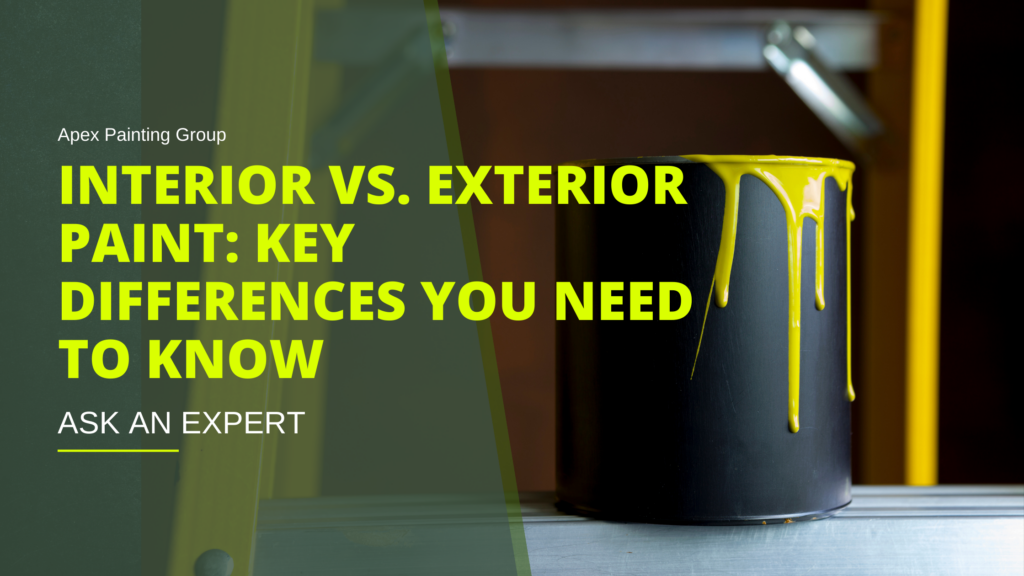
Choosing the right paint for your home or commercial property is crucial. Interior and exterior paints are different. They are designed for various conditions. In this blog, we will explore these key differences of Interior vs. Exterior Paint This will help you make informed decisions for your next painting project.
1. Formulation and Composition
Interior Paint: Interior paint is used inside buildings. It is made to be durable and resistant to scuffing, cleaning, and occasional bumps. Interior paints often have a smoother finish. They contain fewer volatile organic compounds (VOCs). This minimizes odor and improves indoor air quality. The primary components of interior paint include:
- Resins: Provide a smooth, washable surface.
- Pigments: Offer color and opacity.
- Additives: Enhance performance attributes like mildew resistance and scrub-ability.
Exterior Paint: Exterior paint withstands harsh outdoor conditions. It is designed to be robust and resistant to UV rays, moisture, temperature changes, and mildew. Exterior paints usually contain higher levels of VOCs. These help them perform better outdoors. The primary components of exterior paint include:
- Binders: Ensure durability and adhesion to various surfaces.
- Pigments: Provide color and protection against UV damage.
- Additives: Enhance resistance to weather, fading, and mildew growth.
2. Durability and Performance
Interior Paint: Interior paint creates a durable, aesthetically pleasing finish. It can withstand indoor wear and tear. Key performance attributes include:
- Washability: Easy to clean and maintain.
- Stain Resistance: Resists common stains from food, drink, and household products.
- Low Odor: Reduces unpleasant smells and improves indoor air quality.
Exterior Paint: Exterior paint protects surfaces from the elements. It maintains its appearance over time. Key performance attributes include:
- Weather Resistance: Withstands rain, snow, humidity, and temperature changes.
- UV Resistance: Resists fading and degradation caused by sunlight.
- Mildew and Mold Resistance: Prevents growth in damp conditions.
3. Application and Surface Preparation
Interior Paint: Applying interior paint involves preparing surfaces by cleaning, sanding, and priming as needed. Interior surfaces like drywall, plaster, and wood require a smooth finish. Key considerations include:
- Surface Preparation: Ensure walls are clean, dry, and free from imperfections.
- Priming: Use the appropriate primer to enhance paint adhesion and coverage.
- Finish Options: Choose from matte, eggshell, satin, semi-gloss, and gloss finishes, depending on the room’s function and desired look.
Exterior Paint: Applying exterior paint involves more rigorous surface preparation as it will need to hold up to the exterior elements. Key considerations include:
- Surface Preparation: Remove dirt, mildew, and old paint. Repair cracks and holes.
- Priming: Use an exterior-grade primer to ensure proper adhesion and longevity.
- Finish Options: Typically available in satin, semi-gloss, and gloss finishes for added durability and ease of cleaning.
4. Environmental and Safety Considerations
Interior Paint: Interior paint is used indoors, so we recommend choosing options with low or zero VOC levels. This minimizes health risks and odors. Many interior paints are now formulated to be more environmentally friendly and safer for occupants.
Exterior Paint: Exterior paint often contains higher VOC levels. This improves durability and performance in harsh conditions. It is important to always follow safety guidelines and wear protective gear and ensure proper ventilation.
Conclusion
Understanding the differences between Interior vs. Exterior Paint is essential. This knowledge helps achieve the best results in your painting projects. Interior paint focuses on durability, washability, and low odor for indoor environments. Exterior paint withstands weather conditions and protects surfaces from UV rays and moisture.
So if it’s Interior vs. Exterior or if your’e planning on painting both Apex Painting Group can offer a wide range of high-quality interior vs. exterior paints. These are tailored to meet your specific needs. If you want to refresh your home’s interior or protect your property’s exterior, our team of professionals are here to help. Contact us today for a free consultation. Let us bring your vision to life with our expert painting services.
